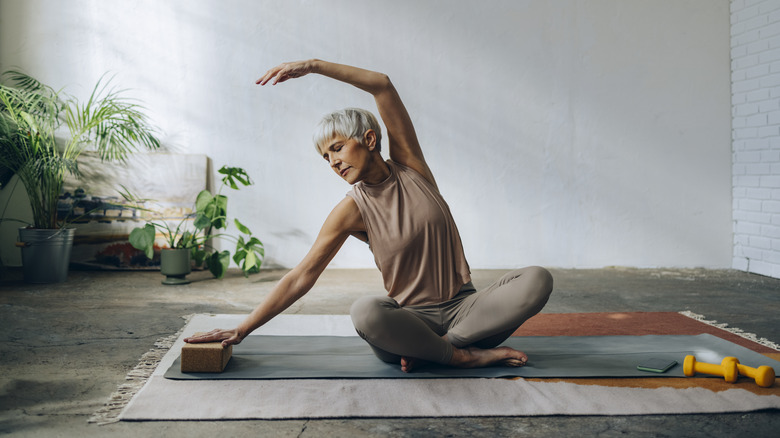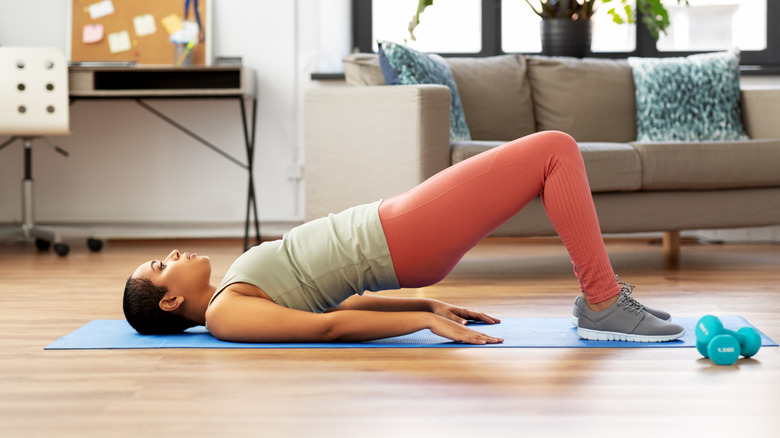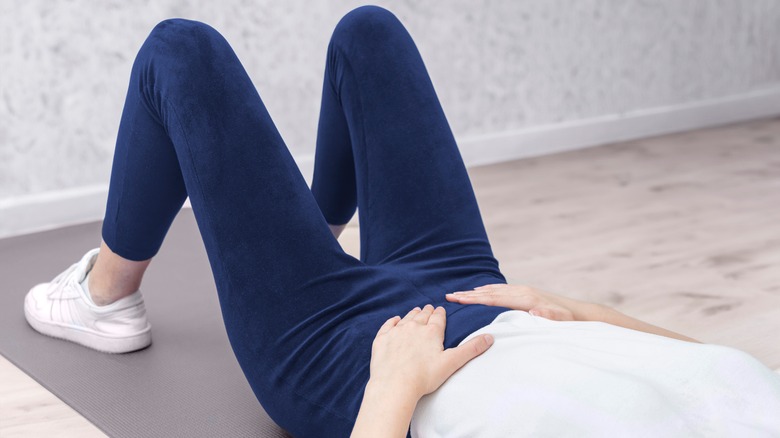The Exercise Mistake That's Making You Look Older
When it comes to the topic of things you might be doing to make yourself look older, we tend to focus on skincare, diet, and exercise as the main cornerstones. It's not uncommon for people over the age of 30 (and sometimes even younger) to start incorporating retinol or vitamin C serums into their skincare regimen or taking collagen pills in the hopes of stalling the signs of aging. When it comes to exercise, we might search online for workouts for different parts of our body to prevent the signs of aging, like bat wing arms, sagging necks, or loose skin in the inner thighs. However, with physical activity, there could also be a tendency to focus on the bigger picture and forget a few small (yet important) details.
We can be so intent on arm, leg, and shoulder days at the gym, getting through a full-body pilates routine, or pumping out those core workouts for a flat belly, that certain fundamental exercises might get left by the wayside. And believe it or not, these mistakes are making us look older. Cue pelvic floor exercises, or in other words, kegel exercises. They're not just for urinary incontinence, post-pregnancy muscle strengthening, or pelvic floor therapy to prevent pelvic prolapse. According to certified strength and conditioning specialist Guy Andrews (via Prevention), they also prevent that soft and round midsection you don't want as you age.
What are pelvic floor exercises?
Your pelvic floor is a collection of muscles and tissues that make up the bed or bottom of your body. It supports pelvic organs like your rectum, vagina, uterus, bladder, and bowels. Picture it like a hammock or trampoline that's holding up an assortment of important organs.
Pelvic floor exercises target the muscles that make up this part of your body. There are different variations you can do, and physical therapists often recommend kegel exercises for any problems with urine leakage, sexual dysfunction, or sometimes even involuntary defecation. Physical therapist Liz Miracle told Real Simple, "It's important to have a well-functioning pelvic floor that's not only strong and able to support your organs to prevent issues like urinary and bowel leakage, but able to relax when needed, so you can actually [go to the bathroom] easily and pain-free." Contrary to what you might think, however, this is not all pelvic floor exercises are good for. They're also about achieving that firm midsection most of us are envious of as we get older. And even if you've never done them before, don't worry. You're never too old to exercise your pelvic muscles.
Part of the challenge with kegel exercises, however, is locating your pelvic floor. It's not always as simple as it sounds. And this is the first step before you think of exercising these muscles, because you don't want to make the mistake of missing the muscles you want to strengthen, shared physical therapist Jessica Valant via YouTube.
How to locate and exercise pelvic floor muscles
Experts usually recommend the urine trick to locate your pelvic floor muscles. While peeing, stop your urine midstream and identify which muscles you're working to do this. These are your pelvic floor muscles. For women, some suggest sticking a clean finger up your vagina and trying to squeeze it using the muscles in there. Whenever you feel pressure on your finger, you're exercising your pelvic floor muscles. For men, you can try pretending to hold in gas (via Harvard Health) or inserting a finger into your rectum and squeezing. If you feel like you're having trouble isolating the exact muscles, see a pelvic floor physical therapist, per Mayo Clinic. They can help you locate the muscles by doing physical exams or biofeedback.
The next step involves doing the exercises. The beauty of these exercises is that you don't even need a workout space to do them. You can do them while sitting at your work desk or lying in bed. Remember the muscles you isolated during the urine test? Isolate and tighten them while breathing normally. Hold for 10 seconds and relax. Make sure your abdominal muscles, thighs, and buttocks remain relaxed when you're working the pelvic floor muscles.
If you want to take the proper exercise route, lie down on your back on an exercise mat with your knees bent and your feet flat on the floor. Connect with your pelvic floor muscles and tighten them. Breathe normally. Hold for 10 seconds and let go. Do three sets a day, and you're well on your way to preventing looking older a lot sooner than you need to.



